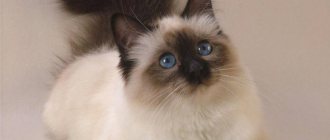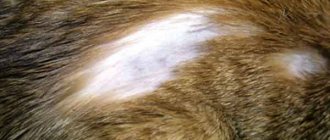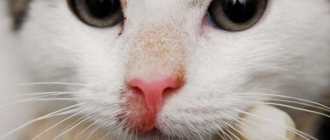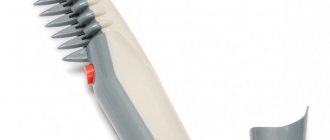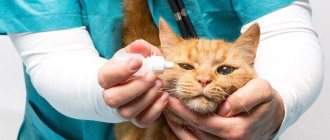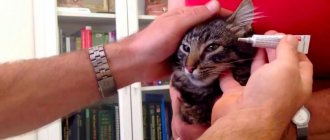Cats, despite their independence and love of freedom, are very gentle and vulnerable creatures. They are supporters of stability. When they are surrounded by familiar objects, people, smells, they feel calm and relaxed. Change of environment is stressful for them. But sometimes we still have to travel with our tailed friends.
To reduce stress and calm the animal, take sleeping pills for cats on the road for comfortable transportation. This will ease their condition and the road will not be a burden to either you or your friend.
In what cases is sleeping pills used for cats?
Sleeping pills for cats are used in cases where it is necessary to ensure the immobility of animals. Most often, this need arises in the following situations:
- when visiting a veterinary clinic: many tests, hardware examinations, preparation for and the conduct of surgical operations themselves require the cat to remain immobile for a long time;
- grooming – the need to use sleeping pills increases with difficult hair cuttings;
- the postoperative period, during which the cat needs complete rest;
- when moving and transporting a pet on a train or plane;
- suffered stress, during which the animal becomes agitated, hyperactive and even aggressive.
Attention! Sleeping pills have a strong effect on the cat's body, so using it without consulting a veterinarian is dangerous - it can be fatal.
The difference between a sleeping pill and a sedative
The sedative does not put the cat to sleep, but simply makes it calm, one might even say lethargic.
If the cat has a long journey ahead, a visit to the veterinarian for a consultation with a doctor or a change of environment can be completely sedated.
This group of drugs is also recommended for use when adding another animal to a cat or during participation in an exhibition.
During periods of sexual arousal, it is better to resort to herbal-based sedatives.
Animal behavior after using sleeping pills
The cat's behavior depends on which drug is chosen for administration. They are divided into groups according to the duration of the effect:
- short-term - after taking them, the cat may not fall asleep, but the body will be completely immobilized, the animal will allow any manipulation with itself;
- medium-term – the cat completely relaxes (both the muscles and the nervous system), while the animal does not feel pain;
- long-term – also has an analgesic effect, the cat is relaxed and will sleep for 8-10 hours.
Important! After sleeping pills, the cat will come to its senses throughout the day. If the animal’s condition has not returned to normal during this time, you should contact a veterinarian.
It is quite difficult to name specific breeds of cats that do not tolerate the effects of sleeping pills well. Veterinarians say that a cat’s condition does not depend on the breed, but on its condition before the administration of sleeping pills. For example, the drug is not recommended for use by pregnant or lactating cats, as well as kittens under 6 months.
When is it necessary to euthanize a cat?
Before looking for different drugs or studying methods that could be used to put a cat to sleep at home without professional help, let's first discuss two concepts:
- euthanasia is a reversible process, as a result of which the animal falls asleep not on its own, but under the influence of medications that affect the functioning of the brain;
- euthanasia is an irreversible process, the deliberate and controlled deprivation of an animal’s life by successively shutting down nervous, cardiac and pulmonary activity in order to end the hopeless long painful existence of the body.
Why do you need to understand the essence of these two terms? To make it easier to understand why you need to euthanize your cat and whether it is possible to do it at home yourself. So let's get started.
It is very rare to meet a calm and obedient cat that will meekly carry out all the commands of its owner. Often, purebred mustachioed shrews behave very impudently and willfully. They show their character in all its glory when they need to be put in a carrier, taken out of the apartment or transported somewhere, especially if the purpose of the trip is to visit the veterinarian.
In such situations, some people prefer to reduce stress for themselves and the animal by putting it to sleep with a short-term sleeping pill. It’s not difficult to do this yourself at home. It is enough to purchase a sedative based on phytocomponents (Fitex, Stop-Stress) from a veterinary pharmacy. Having received the dose required for its weight, the animal calms down and falls asleep.
In addition to herbal sedatives, there are also medications - sleeping pills for animals. With their help, veterinarians put cats into a narcotic state (anesthesia) before complex surgical operations. There is no point in providing a detailed list and dosages of these medications here, since you will not be able to euthanize a cat at home with these medications yourself. They are not freely available without a prescription and cannot be found in pharmacies.
This is where a logical question arises: how then can you alleviate the pain of an old dying animal?
As a rule, cats are euthanized in the most extreme cases, such as:
- An injury that permanently cripples an animal, beyond the possibility of recovery. This type of injury can include spinal fractures, complete loss of several limbs at once, physical damage to internal organs (a broken bone pierced the lung, liver, heart), multiple lacerations of the esophagus due to the animal being poisoned with food containing broken glass, fish hooks or needles, etc. /d.
- The cat is affected by serious diseases, which must be diagnosed by a veterinarian. If a cat can infect a person with a serious disease, you must take it to a veterinarian, and if necessary, he will euthanize it, and subsequently dispose of the animal in accordance with all sanitary safety standards. Hiding an animal that is dangerous in terms of infecting others entails administrative and criminal penalties;
- Emergency life situations, when a person is forced to give up keeping a cat at home, and in order not to condemn it to a dangerous and hungry life in the street environment, or if, due to certain circumstances, the cat cannot be placed in a shelter, it is allowed to be euthanized.
Types of tranquilizers and their effects
In the previous section, we already said that sleeping pills are divided into three groups based on the duration of their effect. Let us describe these groups in more detail.
Short term
After taking them, the cat will sleep for 2-3 hours, most often used for transportation, with increased excitability, stress or sleep disorders.
The most effective drugs in this group:
- Xylanite . Available in the form of a solution for injection. Externally it appears as a colorless or light yellow liquid. Has a calming effect on small pets for 1.5 – 2 hours. It also acts as a pain reliever - in this case it acts for 15-30 minutes. The effect occurs on average after half an hour. Xlanit is administered intramuscularly to cats. The dosage is calculated at 0.15 ml per kg of animal weight.
- Intraval . Puts the cat to sleep for no longer than a quarter of an hour. In case of sleep disturbances, it increases its duration. Also used for convulsive seizures. It is introduced into the body intravenously.
- Barbamil . The drug is indicated for surgical interventions or severe stress. It is given to the cat orally. It is advisable to mix the medicine with a treat for the animal. Before use, consultation with a veterinarian is necessary, since the medicine has a number of contraindications.
Medium term
The animal goes to sleep for 4-5 hours. Prescribed for the treatment of serious mental disorders, severe seizures, and also for preparing a cat for sleep.
- Etaminal sodium . The drug is considered harmless to cats, non-toxic. Copes with nervous excitement and stress. The product is addictive, so it should be used with caution.
- Barbital sodium . The animal falls asleep 1.5 hours after administration. The drug is completely eliminated from the body after 10 hours.
- Chloral hydrate . The drug should not be taken by pregnant or lactating cats, as well as pets under six months of age. The drug has an even larger list of contraindications, so its use should begin after consultation with a veterinarian and under his constant supervision.
Long-term
The drugs induce the cat to sleep for 10 hours and are used only during surgical interventions. The drugs are available only by prescription and are used under the supervision of a veterinarian. When using, the dosage must be strictly observed, otherwise the animal may not wake up after sleeping pills.
- Ketamine . In addition to the main effect - a sleeping pill - the drug has an effect on the cardiovascular system: it stimulates the heart, increasing the heart rate and increasing blood pressure. It is administered intramuscularly and intravenously. The medicine should not be used for animals prone to seizures, as well as for procedures that can provoke seizures.
- Ftorotan . It is introduced into the animal's body by inhalation. It must be used with extreme caution, since the wrong dosage can lead to complete cardiac arrest. Anesthesia occurs quickly, without a phase of motor excitation. At the same time, the animal recovers from anesthesia just as quickly.
- Methoxyflurane. The drug is also administered by inhalation. The effect of the drug takes quite a long time, since its components are easily dissolved in lipids. It is used most often when not only a hypnotic effect is needed, but also an analgesic effect.
Important! Medium- and long-term groups of drugs can only be used for a short period, as they are highly addictive.
Sleeping pills are available in tablet form, but are extremely rare. Most often, the medicine is produced in the form of drops or liquid for the preparation of a solution for injection.
Attention! Drugs intended for humans are not suitable for animals, since the concentration of active substances in them is increased by 10-15 times.
Sleeping pneumatics
Let's start with the most primitive, but very popular and quite effective device.
This “wind-throwing device” complete with “UVYSH-1m” syringes is nothing more than an enlarged modification of school tubes for spitting balls of chewed paper and homemade darts with needles. Well, or a plastic analogue of exotic sarbakans.
The “actual fire” distance is up to 15 meters.
We should immediately briefly talk about flying injection syringes that self-cock when moving along the barrel. They differ mainly in the amount of drug (from rabbit to bear or moose), ballistic characteristics and pusher drive - spring or compressed gas.
You can shoot them not only from a blowpipe. Taking a look at the photographs below, many air rifle owners will begin to look at their “toy” rifles differently.
This is a “UVYSH-651m” kit, consisting of a “Veterinarian-651KS” thrower and a set of syringes. The recommended range of use is up to 10 m, the number of shots on one can is up to 50.
It is not difficult to guess that, in fact, we are dealing with the good old Izhevsk gas-cylinder (CO2) MP-651K, only single-shot and 12 mm caliber. Compare with the prototype:
And this is a pneumatic gun with a larger canister—the “Sanitar” throwing device. It has a range of up to 30 m, and the number of shots has increased to hundreds.
There are also imported analogues. For example, Dan-Inject Model JM Special.
Since neither I nor you, dear readers, are professionals in this field and are not going to make money from this, I don’t see much point in stopping at rifles that cost tens of thousands of rubles.
And finally, even paintball markers are successfully used for remote immobilization purposes.
Most of the devices described above are highly specialized, with calibers ranging from 6.35 mm (.25) to 13 and even 21 mm. And therefore it goes beyond the interests of ordinary amateurs and owners of unlicensed pneumatics of 4.5 mm caliber (.177). But not everything is so bad - rejoice, owners of budget Izhevsk “Murkas”!
Yes, in the photo is MP-512, in this version proudly called the “Lider-3pd veterinary gun set.” Damage range up to 30 meters.
The photo below shows us another old friend - MP-53M, again under the sonorous name “Veterinary device LEAder-1pm”. The firing distance, as expected, is shorter.
These are standard products with declared projectile speeds of 170 and 110 m/s. With no less success, their place could be “Hatsan”, “Gamo”, “Diana” - any spring-piston air rifle or pistol with a broken barrel. Weapons with underbarrel/side cocking or PCP, due to the presence of “clips”, drums and other design features, are mostly not suitable, since the dimensions of bullets and throwing darts are very different.
And here are the darts themselves. On average the price is about 40 rubles per piece. All are branded “Leader”, all are 4.5 mm caliber, differ in ballistic characteristics and properties of the active composition.
For example, “Leader-d” (below) has half the time before the immobilizing suspension begins to work than those that use a hardening paste. And the accuracy, by the way, is higher due to the modified design.
Literally until recently, in addition to owners of PCP and rifles with a fixed barrel, owners of short-barreled gas-cylinder weapons, the drums and magazines of which simply did not fit the dimensions of the darts, were also subject to a kind of “discrimination.” Everything changed with the advent of revolvers with so-called false cartridges (see article “Short barrel”).
The photo shows the LEADER-4pgl kit. This “...hl” in its name seems to come from the company -, but any analogue will do, be it “Cybergan”, “Dan Wesson” or “Smersh”. The undoubted advantage of such a weapon immediately catches your eye - multi-charge capability. As well as a minus - a tiny dart, which means a small amount of active ingredient. Taking into account the known characteristics of such revolvers, we can say that they are designed for short shooting distances and for stray cats and small dogs. However, these animals, no less than wild ones, need treatment and evacuation to holding centers and shelters. And the device itself, if you have shooting skills, will allow you to work in a flock.
How often can you give your cat sleeping pills?
The use of sleeping pills for a cat’s body does not go unnoticed. Therefore, this group of drugs should be used only in extreme cases and as rarely as possible. Before using sleeping pills, the cat should not be fed for 24 hours.
You can also administer sleeping pills yourself. But this can only be done after the veterinarian prescribes the dosage and shows how to administer the medicine correctly.
Under no circumstances should you prescribe the type of medication and its dosage yourself - this can lead to death.
Reception features
When choosing a sleeping pill, you should carefully study the instructions and composition of the medicine. In order not to harm your pet, you should definitely consult a veterinarian about the use of the medicine. The doctor will tell you about the possible side effects of the drug and how to eliminate them. An experienced veterinarian should prescribe treatment with sleeping pills; in no case should you increase the dose of the drug yourself.
If your pet needs a haircut and the journey, for example, to the groomer, does not take much time, you should not give him sleeping pills. In any case, it has a negative effect on the animal’s body, especially on cardiac activity. To pacify the animal, it is better to use herbal-based sedatives that are harmless to the cat’s body: Fitex, Kot Bayun, Stop-Stress and others.
Drugs intended for humans should not be used for cats. This may cause various side effects.
